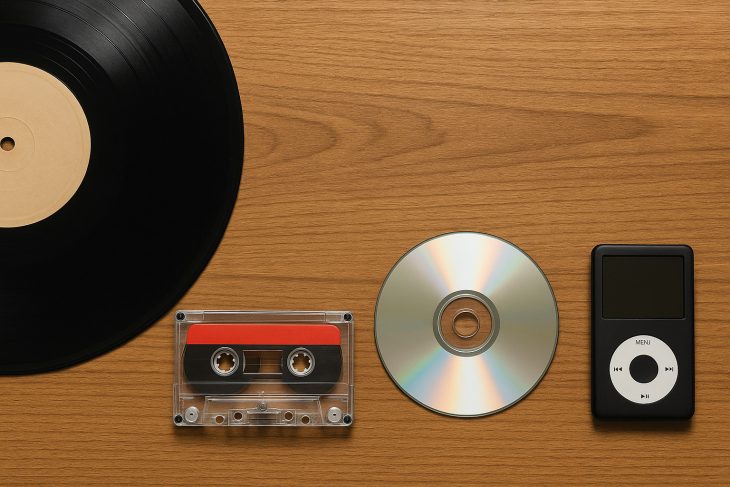
The evolution of music formats charts the journey of sound from grooved discs to invisible streams. Each format offered new ways for listeners to enjoy music. Why has this shift mattered so much? Because it changed how we access, share, and value music. Here are 30 facts showing this fascinating progression.
Vinyl Records: The Golden Era of Analog Sound
Vinyl records marked the beginning of modern music consumption, prized for their sound quality and collectibility.
- The first vinyl records appeared in 1948, introduced by Columbia Records as 12-inch LPs.
- LP stands for Long Play, allowing up to 22 minutes per side.
- Early records spun at 78 RPM, but LPs standardized at 33 1/3 RPM.
- Vinyl sleeves became iconic art forms, helping define artists’ visual identities.
- Record sales peaked in the late 1970s, with over 340 million units sold in 1978 alone.
Cassettes: Compact Portability for the Masses
The compact cassette made music portable and personal, defining the 70s and 80s listening experience.
- Philips introduced the compact cassette in 1963, revolutionizing home recording.
- Cassettes featured magnetic tape, offering up to 90 minutes of music.
- The Walkman debuted in 1979, letting people carry their music anywhere.
- Mixtapes became cultural artifacts, with fans curating custom playlists.
- Cassette sales surpassed vinyl by 1983, becoming the dominant format.
8-Track Tapes: A Brief But Bold Chapter
8-tracks were popular in cars before cassettes took over.
- 8-track cartridges launched in 1965, mainly targeting automotive markets.
- They featured endless loops, which often led to awkward song cut-offs.
- 8-track popularity declined rapidly by the early 1980s, overtaken by cassettes’ superior convenience.
Compact Discs: The Digital Leap
CDs offered durability and perfect sound, becoming the global standard for two decades.
- Sony and Philips co-developed the CD in 1982, using digital audio technology.
- A standard CD holds 74 to 80 minutes of music, designed to fit Beethoven’s Ninth Symphony.
- CD sales peaked in 1999, with over 940 million units sold.
- CD players initially cost hundreds of dollars, making them luxury items in the early years.
- CD-Rs allowed home users to burn their own discs, further personalizing music collections.
MP3s and Digital Files: Music in the Palm of Your Hand
The shift from physical to digital formats brought about portable music libraries.
- The MP3 format was created in 1993, shrinking file sizes without significant quality loss.
- Audio converters allowed users to digitize cassette tapes and CDs into MP3s, making personal music libraries portable.
- The first MP3 player, the MPMan F10, appeared in 1998, holding about a dozen songs.
- Apple’s iPod, launched in 2001, stored up to 1,000 songs, redefining music consumption.
- Digital downloads surpassed CD sales for the first time in 2012, marking a significant shift.
Streaming: Instant Access, Infinite Libraries
Streaming changed music from ownership to access, with millions of songs available on demand.
- Napster, launched in 1999, pioneered peer-to-peer music sharing, though it faced legal issues.
- Spotify introduced legal music streaming in 2008, using a freemium model.
- Tidal, founded in 2014, promoted high-fidelity streaming, catering to audiophiles.
- By 2024, over 600 million people globally subscribed to music streaming services.
- Streaming services now contribute over 80% of global music industry revenue.
The Comeback of Vinyl and Niche Formats
Old formats never truly vanish; many resurge due to nostalgia and collector interest.
- Vinyl records experienced a resurgence starting in the mid-2000s, outselling CDs in some markets by 2020.
- Cassette tapes also saw limited comebacks, especially among indie bands and collectors.
Reflecting on the Journey of Music Formats
Music formats have continuously shaped how we experience sound. From fragile shellac discs to intangible streams, each step reflects changes in technology and culture. The current landscape blends streaming convenience with nostalgic revivals, offering listeners endless choices. The journey of music formats shows no sign of stopping, with the next innovation always waiting to play the next track.
Was this page helpful?
Our commitment to delivering trustworthy and engaging content is at the heart of what we do. Each fact on our site is contributed by real users like you, bringing a wealth of diverse insights and information. To ensure the highest standards of accuracy and reliability, our dedicated editors meticulously review each submission. This process guarantees that the facts we share are not only fascinating but also credible. Trust in our commitment to quality and authenticity as you explore and learn with us.


